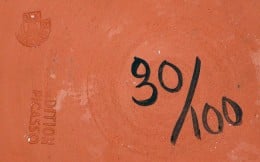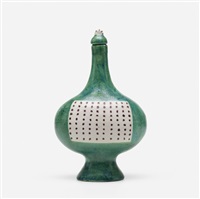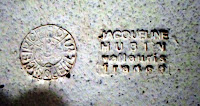Paris Pottery Arts - Discovering Lost Treasures
Blogger Kim Paris uses her knowledge of Art Pottery to discover lost discarded treasures from thrift stores
Sunday, January 26, 2020
Paris Pottery Arts - Discovering Lost Treasures: Tang Pottery and SBCD - Paris Pottery Blog
Paris Pottery Arts - Discovering Lost Treasures: Tang Pottery and SBCD - Paris Pottery Blog: I had an hour and a half today to treasure hunt, so I went to two thrift stores. One is a large chain store ran and operated by a local...
Thursday, January 23, 2020
Tang Pottery and SBCD - Paris Pottery Blog
I had an hour and a half today to treasure hunt, so I went to two thrift stores. One is a large chain store ran and operated by a local church and the other is a small thrift store owned by the Assistance League of Salt Lake City and operated exclusively by elderly volunteer ladies. The first store was one I dreaded going to. It’s overcrowded and lots of junkers are there every single day. They get a shopping cart and perch themselves right next to the swinging doors where they roll out the latest donated items. They pride themselves on being the first to pick every new lot. I feel a bit out of place in the store and I refuse to squeeze and push people aside to look for the new rolled out items on the cart. So if I miss $100,000 hopper edging because I won’t push past people, I will just have to live with that. I also hope my years of sifting through junk looking for pottery have afforded me a keen eye to see what others can’t without having to be rude.
Today at this store in the display case I found two small terra-cotta figurines. They looked old, they smelled old (yes I smelled them), and the form seemed right. I believe they could be around 1,200 years old. On the service they appear to be Tang Dynasty female tomb figures. The faces are expressive and the terra-cotta edges are smooth rather than sharp. You can tell they’ve been handled a lot, as there’s a darkness to the areas where one naturally holds. What’s left of the paint is distinct worn off layers, and the style of hair and clothes is appropriate. My main concern is how prevalent Chinese fakes are today and without the TL test (thermoluminescence), which costs on average $500 to administer, it is impossible to tell. But they are nice and too good to pass up. I bought them for five dollars a piece.
Today at this store in the display case I found two small terra-cotta figurines. They looked old, they smelled old (yes I smelled them), and the form seemed right. I believe they could be around 1,200 years old. On the service they appear to be Tang Dynasty female tomb figures. The faces are expressive and the terra-cotta edges are smooth rather than sharp. You can tell they’ve been handled a lot, as there’s a darkness to the areas where one naturally holds. What’s left of the paint is distinct worn off layers, and the style of hair and clothes is appropriate. My main concern is how prevalent Chinese fakes are today and without the TL test (thermoluminescence), which costs on average $500 to administer, it is impossible to tell. But they are nice and too good to pass up. I bought them for five dollars a piece.
 |
| Possible Tang Dynasty (618-907) Tomb Figures Female |
The second store was a breath of fresh air compared to the last one. It’s small, clean, and easy to look through with a spare 30 minutes. At this store I picked up an art pottery pitcher by SBCD (Santa Barbara Ceramic Design). I recognized the mark from a small but beautiful arts and craft flower vase I found last year. SBCD was founded in 1976 by Raymond Markow. With a large portion of creative pottery manufacturers moving to Asia during this time, SBCD was a unique West Coast home grown producer of hand thrown, hand painted decorative and functional art pottery. Their unique pieces are indicative of the arts and craft movement of early American pottery companies like Weller and Roseville. While the craftsmanship is impeccable, unfortunately late 20th century arts and crafts pottery is not always a big seller these days and I’d be lucky to get $40 for it. I bought it for the price of seven dollars. I’ll keep you posted.
 |
| SBCD Toucan pottery pitcher by Alvaro Sumon a local Chicano artist most famously known for his painting La Llorona, The Wailing Woman (see below) |
Labels:
Ancient,
Antique,
Art Pottery,
Chinese Pottery Attendant,
Chinese Pottery Tomb Figure,
Han Dynasty,
Paris,
Pottery,
Santa Barbara Ceramic Design,
SBCD,
Tang Dynasty,
Treasure
Location:
Salt Lake City, UT 84124, USA
Wednesday, January 22, 2020
Hopi Pottery - Paris Pottery Blog
 |
| Hopi pottery figure. Woman grinding corn. Early 20th century |
I often wonder why with the little free time I have that I choose to spend it scanning isle after isle of used junk. I am obsessed. It’s my favorite hobby to the point that my husband would sooner believe I am having an affair than spending so much time at thrift stores and estate sales. Am I hard up for cheap goods? No. Do I love florescent lighting and wasting my time? No. Do my friends wonder why I would rather “run errands” than meet them for lunch? Yes. Do I love treasure hunting? Yes! It is an embarrassing hobby like playing the lottery. The chances you find an amazing piece of art or history is so tenuous but there is a chance. And while I never (rarely) find something I could take to the bank, I do, more often than not find something interesting. A treasure lost amongst the rubbish that I can dust off and save from obscurity.
Now, I am not a hoarder. In fact I only personally keep things I absolutely love and will display in my home. I do not like clutter and junk. I’ve been to enough estate sales to see firsthand what happens when you hold onto things and it’s not good. I sometimes sell the things I find on eBay but this is also rarely worth my time. What I like most about doing this is the discovery. Not knowing about a piece but being curious enough to research its origins and find its history, to me it’s a beautiful thing.
My latest find was a Native American hand formed open fired figure of a woman grinding corn and preparing fish. Who made this? When was it made? Which tribe made it? Why was it made? I love finding the answers to these things and sometimes I’m good at it. I’ve done entire family trees for distant friends because I love digging into the past and finding answers.
I am reinvesting in this blog to share what I find to anyone is interested in taking a journey with me into the history of our civilization through art and pottery. I also think It is important to in share the monetary value of items and what they are really worth. Not Sotheby’s auction worth, everyday Let-go, eBay or Etsy values. I try to find a little time every week to treasure hunt. Here on this blog I will show my findings, what I find out about them, how much I paid, how much they are worth, and how much I can actually sell them for. I primarily focus on pottery because I love it and it makes me happy.
Tuesday, September 12, 2017
Jaqueline "Jacotte" Hubin and Roger Capron, Vallauris (Picasso Inspiration?)
Jaqueline "Jacotte" Hubin and Roger Capron, Vallauris
Vallauris is a commune in southeastern France near Cannes. During the middle of the 20th century it became a producer of some the most innovative, free-spirited and accomplished art pottery of the time. While this region has a long history of making European pottery, it hadn't gained notoriety until the emergence of artists like Clement Massier, and George and Suzanne Ramie. Pablo Picasso is the most well known of the Mid century Vallauris potters and his works are well documented but there are other great lesser known Artists from that region that deserve our respect and adoration. Artists that inspired Picasso himself and gave way to the birth of a abstractism and contemporary pottery art as we know it today.
A couple of these artists are Jaqueline "Jacotte" Hubin and Roger Capron. Roger was a French ceramist born in 1922 and Jacqueline, a Vallauris native, was born in 1935. Roger, a former student the School of Applied Arts to Art and Industry of Paris, travelled to Vallauris in the company of Robert Picault in 1446. He wasted no time in creating his first ceramics workshop named “Callis” in 1947. Artist Jean Derval joins them that same year. In 1952 he left the “Callis” workshop for a small ceramics creations factory. In 1953 he exhibited at the “Maison de la Chimie” with Jean Jouve and Line Vautrin. His creations were colorful and modern with linear concepts and abstract forms. Wonderfully geometric with occasional incised Paleolithic imagery of animals or human figures. He utilized many different techniques including “garrigues stoneware”. In 1955 he married Jacqueline Hubin AKA “Jacotte”, his collaborator-to be and artist in her own right. Although their works of art still today adorn the streets of Vallaurus and souther France, Roger and his wife struggled financially , at one point filling for bankruptcy and selling their patents. Roger died in 2008 and Jacqueline in 2016.
I found the above piece of " Jacotte's" work at an estate sale. This piece seems to me heavily inspired by Picasso, or maybe it was Picasso inspired by Jacotte.
Wednesday, January 25, 2017
Most Valuable Pottery Marks- Pablo Picasso
Most Valuable Pottery Marks
Picasso Ceramics
In the 1940's Pablo Picasso, inspired by a visit to a Vallauris Pottery exhibit, began crafting and designing his own line of pottery with the help of Suzanne and Georges Ramie. He used their workshop in the South of France and over time produced 25 years worth of Picasso Pottery. Even though Pablo Picasso only designed most of the ceramics and did not actually throw them with his own hands they are still worth incredible amounts of money. And because of his continued popularity, his ceramics are in high demand. A Picasso Madoura Edition Ceramic piece on can bring $2000-200,000, and if you happen to find an original painted by the master himself it could bring as much as $3,000,000.





Tuesday, January 24, 2017
Guido Gambone
 |
| Jackson Pollock |
I recently watched a documentary titled Mural: The Story of a Modern Masterpiece. It's a film about a famous Jackson Pollock painting commissioned by Peggy Guggenheim and gifted to the University of Iowa in 1948. The painting is an immense (8’ 1 1/4” x 19’ 10”) abstract mid-century masterpiece, colorful and layered. Dark abstract figures in a procession of movement drift across the canvas while the surrounding atmosphere comes alive with typical intense Pollock brushwork infused with energy and color. What is it about certain artists that draws you in and comforts your senses?
Guido Gambone is one of these artists. Guido was born in 1908 near Avellino, Italy. When he was a teenager his family moved to Vietra, an area well known for pottery. He soon quite school and took an internship at Francesco Avallone's ceramic manufacturer. Later he trained at ICS and eventually became the director. Over the years the founded his own pottery manufacturers La Faezeralla and La Tirenna. Guido became one the primary firgures in the world of Modern ceramics.
With Guido, his pottery needs no narration. The images alone set his work apart from the masses and tell the story of a mid-century nonconformist that defies not only his time but ours as well. His sense of color and lines, proportion and fluidity, abstract-ism, cubism, sculpture and playfulness never tires of being looked at. The outward effect is simple only in the way it makes you feel. The color pallets of the glazes he so aptly utilizes were non existent in the middle of the 20th century. He created these to suit a modern movement that was started in his head alone. He perfected the application as well. Sharp geometrical lines and form, crackle, lava glaze and multi-layer glaze applications in the most striking hues. His finishes can be stunningly crisp or perfectly soft and muddled for an added dreamy effect.
There is no question when looking at a Guido Gambone that it is handmade and free-formed. That is part of the charm. He exhibits a contemporary earthiness that could have been lost in the drab violets, maroons and the cobalt's of its time and yet comes to life with color, refinement, imagination and skill.
Guido Gambone







Wednesday, January 18, 2017
Father Anthony Art Pottery
 |
| Father Anthony |
You should surround yourself with the things you love, unfortunately some of my loves are way too expensive. Maybe that is a good thing, to get everything you want all the time leaves no space for desire and then passion. I am a stay at-home-mom, a dying breed in my circles, and with one income supporting five you tend to educate your hobbies rather than invest in. This long education of Art, specifically pottery has afforded me a knowledge of an artists skill and talent, and every once and awhile I discover a gem that in it's obscurity is affordable. Introducing Father Anthony.
Father Anthony is a Trappist monk who lives in the pristine hills of Napa Valley, California at the Abbey of New Clairvaux Monastary. He was born in Philadelphia in 1935 and studied Business and Engineering at Drexel University where he received a B.S. degree in Commerce in 1957. In 1963 he entered the Dominican Order and received a degree in Philosophy and an advanced degree in Theology from Saint Albert’s in Oakland. Father Anthony was ordained a priest in 1969 and entered the Abbey of New Clairvaux in 1972 where he has remained ever since. Here at the Abbey is where he found his love and talent for pottery.
I came across one his pieces at a thrift store and immediately noticed the fluidity and lightness of his work. The glaze was outstanding, even, carefully fired, with a color that evokes ones imagination. It's a simple vase made with complicated techniques, finishes, and the spirit of an artist who long ago was comfortable with his work.
His works are still for sale at the monasteries gift shop for modest prices and I wouldn't wait. I have a feeling with time he will be recognized as one this centuries art pottery elites.
Subscribe to:
Comments (Atom)





